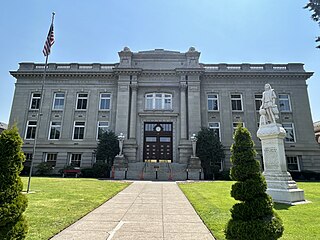
Walla Walla County is a county located in the southeast of the U.S. state of Washington. As of the 2020 census, its population was 62,584. The county seat and largest city is Walla Walla. The county was formed on April 25, 1854 and is named after the Walla Walla tribe of Native Americans.
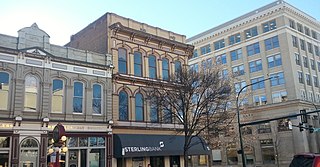
Walla Walla is a city in and the county seat of Walla Walla County, Washington, United States. It had a population of 34,060 at the 2020 census, estimated to have decreased to 33,339 as of 2023. The population of the city and its two suburbs, the town of College Place and unincorporated Walla Walla East, is about 45,000.

Whitman Mission National Historic Site is a United States National Historic Site located just west of Walla Walla, Washington, at the site of the former Whitman Mission at Waiilatpu. On November 29, 1847, Dr. Marcus Whitman, his wife Narcissa Whitman, and 11 others were slain by Native Americans of the Cayuse. The site commemorates the Whitmans, their role in establishing the Oregon Trail, and the challenges encountered when two cultures meet.

This is a list of properties and historic districts in Washington that are listed on the National Register of Historic Places. There are at least three listings in each of Washington's 39 counties.

Ellis Fuller Lawrence was an American architect who worked primarily in the U.S. state of Oregon. In 1914, he became the co-founder and first dean of the University of Oregon's School of Architecture and Allied Arts, a position he held until his death.
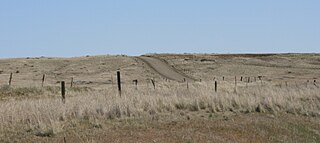
Mullan Road was the first wagon road to cross the Rocky Mountains to the Inland of the Pacific Northwest. It was built by U.S. Army troops under the command of Lt. John Mullan, between the spring of 1859 and summer 1860. It led from Fort Benton, which at the time was in the Dakota Territory, then Idaho Territory from July 1863, and into Montana Territory beginning in May 1864. The road eventually stretched all the way from Fort Walla Walla, Washington Territory, near the Columbia River to the navigational head of the Missouri River, which at the time was the farthest inland port in the world). The road previewed the route approximately followed by modern-day Interstate 15 and Interstate 90 through present-day Montana, Idaho, and Washington.
The Liberty Theatre is a former Broadway theatre in New York City.
Northern Pacific Depot, Northern Pacific Railway Depot, Northern Pacific Passenger Depot, Northern Pacific Railroad Depot, or Northern Pacific Railway Passenger Depot may refer to the following stations in the United States:

The Emory Place Historic District is a historic district in Knoxville, Tennessee, United States, located just north of the city's downtown area. The district consists of several commercial, residential, religious, and public buildings that developed around a late nineteenth century train and trolley station. The district includes the Knoxville High School building, St. John's Lutheran Church, First Christian Church, and some of the few surviving rowhouses in Knoxville. The district was listed on the National Register of Historic Places in 1994, with a boundary increase in 2023.

Walla Lutheran Church is a historic church in rural Roberts County, South Dakota, in the United States.It was added to the National Register of Historic Places in 2004.
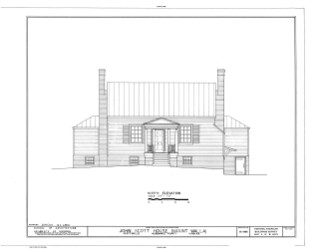
Mount Walla is a historic home located near Scottsville, Albemarle County, Virginia. It was built between 1820 and 1840, and is a 1 and 1/2-story, hall and parlor plan frame Federal-style dwelling. The house received a series of additions during the second half of the 20th century, more than doubling its size. Also on the property is a contributing smokehouse. The property also includes a family cemetery with Victorian iron fence. In 1836, the property was purchased by Peter Field Jefferson, grandnephew of the president.
Osterman and Siebert was an American architectural firm in Walla Walla, Washington. Henry Osterman was senior partner.

Virginia Avenue District is a national historic district located at Indianapolis, Indiana. The district encompasses 43 contributing buildings and 1 contributing structure in the Fountain Square Commercial Areas of Indianapolis. It developed between about 1871 and 1932, and notable buildings include the Sanders (Apex) Theater (1913), Southside Wagon and Carriage Works / Saffel Chair Company, Fountain Square Theater (1928), Woessner Building, Granada Theater (1928), Southside Theater (1911), Schreiber Block (1895), Fountain Square State Bank (1922), and Fountain Bank (1902).

The Walla Walla Valley Traction Company Car Barn, at 1102 W. Cherry in Walla Walla, Washington, was built in 1906. It was listed on the National Register of Historic Places in 1989.
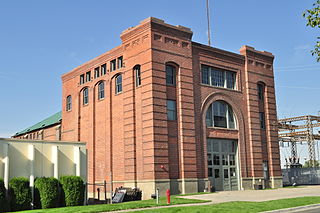
The Electric Light Works Building, also known as Gesa Power House Theatre, is a noteworthy building in Walla Walla, Washington that has aided in the growth and success of the city. It started out as a substation in the early 20th century, supplying Walla Walla with electricity. It was one of the first substations that converted hydropower to electricity in Washington state and is a good example of industrial architecture in the 1900s. Today it is as much a symbol of Walla Walla’s history as it is of the ever-changing culture of Walla Walla.















